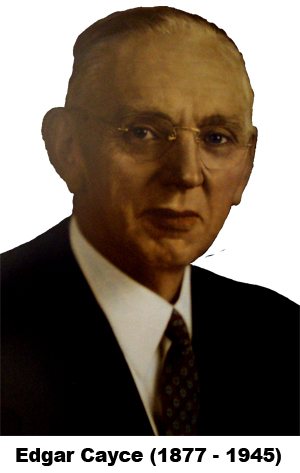Edgar Cayce
 Edgar Cayce was a 20th-century American mystic. On an almost daily basis, Cayce entered a self-induced altered state of consciousness that allowed him to answer questions of almost any nature ranging from medical conditions to the origin and nature of the cosmos. His psychic dissertations became known as “readings” and were assigned numbers to protect the privacy of those who sought his guidance.
Edgar Cayce was a 20th-century American mystic. On an almost daily basis, Cayce entered a self-induced altered state of consciousness that allowed him to answer questions of almost any nature ranging from medical conditions to the origin and nature of the cosmos. His psychic dissertations became known as “readings” and were assigned numbers to protect the privacy of those who sought his guidance.
Many of the Cayce readings speak of the soul and its incarnation in the physical body through definite anatomical "centers" - specific glands and nerves. In particular, two glands were singled out as the "seat of the soul" - the Leydig and the pineal. Both are obscure and to some degree "hidden" within the body. So much so, that we are not really sure what Cayce was referring to when he spoke of the Leydig gland. That's one of the objectives of this website, to identify the anatomy and physiology of this gland within the body. The significance of the "seat of the soul" is that is functions as the body-soul connection, allowing spirit to manifest.
Cayce's readings insist that spirit is the life or lifeforce in the body. It is a low electrical vibration that operates at a cellular level to reproduce and regenerate the system. However this Creative Energy, which is synonymous with God in a material sense, can be raised in its intensity, resulting in altered consciousness, powerful healing effects, and increased creativity and productivity. Or, if the energy is misused or misdirected, it can have powerful pathological effects.
At this higher level of intensity the Creative Energy is sometimes called Kundalini, in reference to the practice of kundalini yoga or kundalini meditation, a traditional approach to working with this potent force. With the opening of the spiritual centers, and especially the closed door of the Leydig gland, this kundalini energy moves upward along the spine to the pineal gland in the center of the brain. As it moves along the spine it is distributed through certain key nerves plexuses and thence to endocrine glands that are called spiritual centers.
In the eastern spiritual traditions, the interaction of kundalini energy through the nerves and gland centers has been witnessed by adepts with psychic vision who have designated these whirling vortexes of energy as chakras. The Cayce readings assert that this kundalini, lifeforce energy, moving through these centers, is responsible for the development of the fetus in the womb of the mother during pregnancy.
Thus, when the kundalini is activated during deep meditation, the primal pattern of creation is again taking place within the inner self – the soul in its connection with the physical body. The creative energy that formed the body is accessible for regeneration. Therefore, the potential for healing – of self and others – is available to those who know how to use deep meditation for this purpose.
The raising of this lifeforce energy also provides a channel for communion with the divine within. In meditation, the physical, mental, and spiritual dimensions of the soul entity are brought into attunement with their Source. Persons practicing deep meditation sometimes report mystical encounters with God – of being in the presence of the divine.
So the Cayce concept of the seat of the soul is expansive, yet personal and practical in the activities that are distinctly human. Understanding and applying knowledge of the body-soul connection is a means of soul growth, in service to humanity.
 Edgar Cayce was a 20th-century American mystic. On an almost daily basis, Cayce entered a self-induced altered state of consciousness that allowed him to answer questions of almost any nature ranging from medical conditions to the origin and nature of the cosmos. His psychic dissertations became known as “readings” and were assigned numbers to protect the privacy of those who sought his guidance.
Edgar Cayce was a 20th-century American mystic. On an almost daily basis, Cayce entered a self-induced altered state of consciousness that allowed him to answer questions of almost any nature ranging from medical conditions to the origin and nature of the cosmos. His psychic dissertations became known as “readings” and were assigned numbers to protect the privacy of those who sought his guidance.